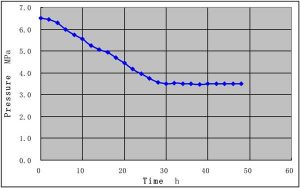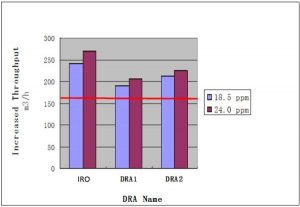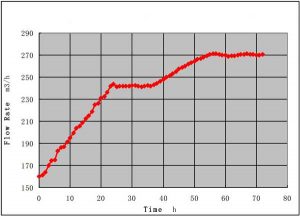IRO DRA products have been successfully applied in many pipelines with excellent performance. Two typical cases are given to illustrate.
DRA Application Cases
- Application Case 1
- Application Case 2
CASE 1 (Pressure reduction): Yanji Pipeline
Table 1: Pipeline situation and material profile
| Pipeline Situation | Location | Length | Diameter | Pump Station | OTR | Operating Pressure | Designed Flow Rate |
|---|---|---|---|---|---|---|---|
| Shan'xi, China | 452km | 323.9mm | 4 | 70-25℃ | 6.5MPa Max. | 305m3/h | |
| Material Profile | Transmissed Material | Oil Viscosity Under Operation | Reynolds number | ||||
| Light Crude Oil (wax-based) | 30 mPa.s (average) | 32000 | |||||
Requirements
YanJi Pipeline transmits crude oil from the oilfield to refinery plants nearby. While maintaining the flow rate at the designed level, i.e. 305m3/h, the maximum operating pressure needs to be reduced from 6.5MPa to 4.5 MPa for ensuring the safety of the pipeline, which is severely corroded due to inferior maintenance. DRA was considered as the only feasible method.
Operation
Injecting drag reducing agent at 10ppm to discharge side of each boosting pump until the oil stream in the whole pipeline bearing a certain amount of DRA. The flow rate (305m3/h) was stably kept while the outlet pressure of each pump station was recorded.
Achievement
When the oil-bearing 10ppm stream was filled the whole pipeline (that is, those DRA-bearing oil totally replaced pure oil), the operation pressure dropped down to 3.5MPa from the original 6.5 MPa, attaining 46% drag reduction rate about 46%. The requirement is satisfied.
Chart 1: Outlet pressure of pump station 1 during DRA injection
CASE 2 (Output Increase): Shi-Ke Pipeline
Table 1: Pipeline Situation and Material Profile
| Pipeline Situation | Location | Length | Diameter | Pump Station | OTR | Operating Pressure | Designed Flow Rate |
|---|---|---|---|---|---|---|---|
| Xinjiang, China | 148km | 377mm | 3 | 60-17°C | 6.5MPa Max. | 160m3/h | |
| Material Profile | Transmissed Material | Oil Viscosity Under Operation | Reynolds number | ||||
| Heavy crude oil (Aspaltene-based) | 120mPa.s (average) | 5000 | |||||
Requirements
Shi-Ke pipeline was laid for delivering crude oil to a refinery 148 km away, whose capacity was increased in 2011. Thus, the higher delivery capacity of crude oil was needed. However, the maximum designed output of this pipeline is only 160m3/h, far below the required 240 3/h volume.
Then, two solutions were proposed. One was to establish more boosting pumps. The relevant cost and time are considerably high. The other is to add DRA. The customer preferred the latter from an economical perspective. However, they were not confident in DRA at first, since there is no precedent for increasing the output up to 50% before. Our deliberate proposal with a thorough calculation finally convinced the pipeline operator to try. Two other DRA products were also to be applied for comparison.
Operation
Continuously injecting DRA (18.5ppm to 24ppm) at the discharge side of each boosting pump until the oil stream in the whole pipeline bearing DRA.
Achievement
When our DRA product was injected to 18.5ppm, pipeline output increased from 160 m3/h to 242 m3/h. The increase rate was 51%, which already met the required 50%. When the dosage rose to 24ppm, the output further boosted to 270 m3/h. The increase rate was up to 69%.
Performance Comparison
| DRA Name | IRO Quickflow/F | DRA 1 | DRA 2 |
|---|---|---|---|
| Original Q m3/h | 160 (DRA injected at 18.5 and 24.0 ppm for all DRAs below respectively) | ||
| Increased Q | 242 | 190 | 212 |
| 270 | 207 | 225 | |
| Rate of Q % | 51 | 19 | 33 |
| 69 | 29 | 41 | |
Chart 1: Outlet pressure of pump station 1 during DRA injection
Chart 2: Outlet pressure of pump station 1 during DRA injection








